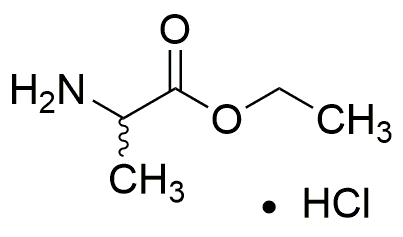DL-Alanine ethyl ester hydrochloride is widely utilized in research focused on:
- Pharmaceutical Development: This compound serves as an intermediate in synthesizing various pharmaceuticals, particularly in the formulation of drugs targeting metabolic disorders.
- Biochemical Research: It is used in studies involving amino acid metabolism, helping researchers understand metabolic pathways and enzyme functions.
- Food Industry: As a flavor enhancer, it can improve the taste profile of food products, making it valuable for food scientists and manufacturers.
- Cosmetic Formulations: Its properties make it suitable for use in skincare products, where it acts as a moisturizing agent, benefiting cosmetic chemists.
- Protein Synthesis: In laboratory settings, it is utilized to produce peptides and proteins, aiding researchers in biotechnology and molecular biology.
General Information
Properties
Safety and Regulations
Applications
DL-Alanine ethyl ester hydrochloride is widely utilized in research focused on:
- Pharmaceutical Development: This compound serves as an intermediate in synthesizing various pharmaceuticals, particularly in the formulation of drugs targeting metabolic disorders.
- Biochemical Research: It is used in studies involving amino acid metabolism, helping researchers understand metabolic pathways and enzyme functions.
- Food Industry: As a flavor enhancer, it can improve the taste profile of food products, making it valuable for food scientists and manufacturers.
- Cosmetic Formulations: Its properties make it suitable for use in skincare products, where it acts as a moisturizing agent, benefiting cosmetic chemists.
- Protein Synthesis: In laboratory settings, it is utilized to produce peptides and proteins, aiding researchers in biotechnology and molecular biology.
Documents
Safety Data Sheets (SDS)
The SDS provides comprehensive safety information on handling, storage, and disposal of the product.
Product Specification (PS)
The PS provides a comprehensive breakdown of the product’s properties, including chemical composition, physical state, purity, and storage requirements. It also details acceptable quality ranges and the product's intended applications.
Certificates of Analysis (COA)
Search for Certificates of Analysis (COA) by entering the products Lot Number. Lot and Batch Numbers can be found on a product’s label following the words ‘Lot’ or ‘Batch’.
*Catalog Number
*Lot Number
Certificates Of Origin (COO)
This COO confirms the country where the product was manufactured, and also details the materials and components used in it and whether it is derived from natural, synthetic, or other specific sources. This certificate may be required for customs, trade, and regulatory compliance.
*Catalog Number
*Lot Number
Safety Data Sheets (SDS)
The SDS provides comprehensive safety information on handling, storage, and disposal of the product.
DownloadProduct Specification (PS)
The PS provides a comprehensive breakdown of the product’s properties, including chemical composition, physical state, purity, and storage requirements. It also details acceptable quality ranges and the product's intended applications.
DownloadCertificates of Analysis (COA)
Search for Certificates of Analysis (COA) by entering the products Lot Number. Lot and Batch Numbers can be found on a product’s label following the words ‘Lot’ or ‘Batch’.
*Catalog Number
*Lot Number
Certificates Of Origin (COO)
This COO confirms the country where the product was manufactured, and also details the materials and components used in it and whether it is derived from natural, synthetic, or other specific sources. This certificate may be required for customs, trade, and regulatory compliance.


